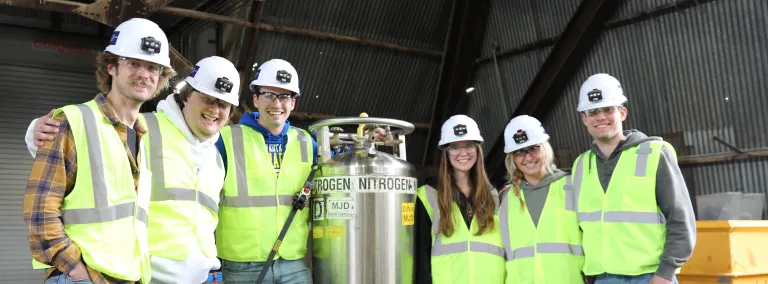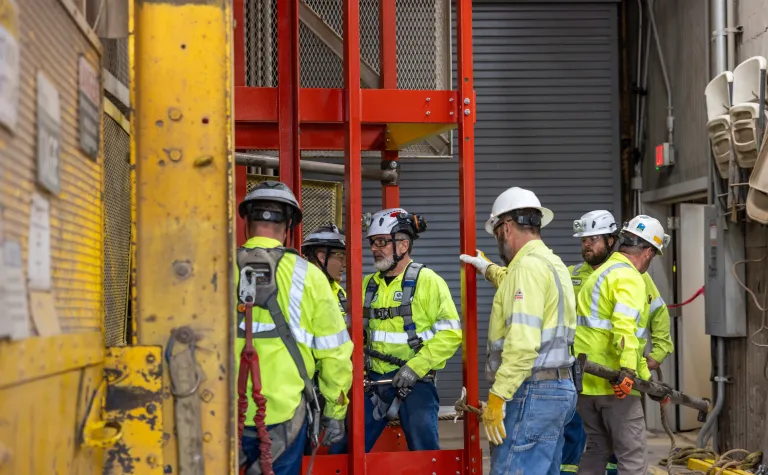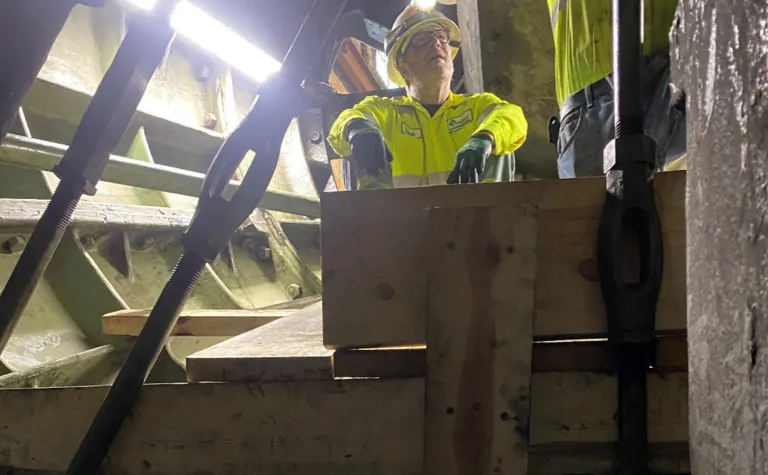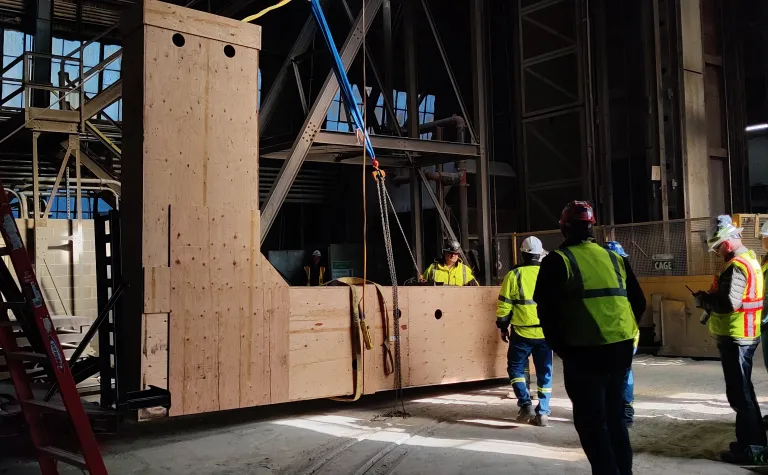SDSU engineering teams exemplify value of soft skills in SURF projects
Two student engineering teams at SDSU spent their senior year on capstone design projects at SURF. One team built a new mine rail cart for hauling liquid nitrogen underground. The other built a drone for inspecting hard to reach vertical shafts.
If you ask the South Dakota State University student engineering team what they learned over the past year designing and building a heavy-duty rail car for transporting containers of liquid nitrogen a mile underground, you will get one answer — almost in unison, “teamwork.”
The transporter they designed for use at the Sanford Underground Research Facility had no shortage of technical challenges. The mine rail cart includes a dual hydraulic lift powered by an electric motor to ease loading, unloading and transporting 600-pound dewars, which are each like a giant thermos full of liquid nitrogen.
The cart was built to travel along rails from the surface, into an elevator lift called a cage, and out to the physics experiments 4,850 feet underground at SURF. Read more about their award-winning project in this article from SDSU.
Maybe surprisingly, the technical obstacles in completing a complex design-build project on a deadline were not the biggest takeaway for this team of mechanical engineering majors.
“We learned the value of working together and recognizing strengths and weaknesses in ourselves in a group setting,” said Alli Krantz. “We all played our parts, everybody had their role, and we all got it done,” added Braden Hanson.
Employers who hire engineering students are often looking for those who have mastered the technical aspects of the trade and who also have developed other vital “soft skills.” This means things like teamwork, emotional intelligence, empathy, and the ability to clearly and effectively communicate the nuances of complex projects with others.
“This experience will help me most if I ever have to form a team or lead a team of my own, because now I've learned that it's very valuable to quickly figure out what everyone's skill sets are so you can come together to become the strongest team that you can make,” Phil Baker said.
Team brought energy, ingenuity to SURF
Luke Degen, another member of the team, who are all senior mechanical engineering majors, took this idea one step further. “I also learned that when you are part of an existing team, look around and see what you can do to modify your own skill set, or seek skills outside the team, to make everyone successful,” Degen said.
Any engineering project can still pose significant challenges, and Krantz adds that another takeaway might be that what happens in a textbook doesn’t always transfer to the real world.
“You think you know what you are doing until you work on a hands-on project,” Krantz said along with nods from others on the team.
Chad Dunbar, a mechanical engineer at SURF who worked with this team over the last year, expressed pride in the hard work and accomplishments of these students.
“The SDSU student team brought tremendous energy and ingenuity to SURF with their rail car project,” Dunbar said. “Designing a system to handle heavy liquid nitrogen dewars in a challenging underground environment was no small task. Their ability to collaborate, adapt and communicate effectively as a team was outstanding and will benefit SURF’s mission moving forward."
Quadcopter brings eyes to remote shafts
The teamwork needed to tackle real-world problems was also vital in the successes of another SDSU engineering team that spent the last year building a quadcopter drone to fly into vertical shafts at SURF.
The team’s goal was to come up with a way to survey these hard-to-reach vertical spaces. The student team did the impressive work of designing and building the flying machine from scratch. This included constructing the frame, writing the computer code and assembling parts like circuit boards, electric motors, blinding LED lights and a 360-degree camera to capture the inside of the shaft.
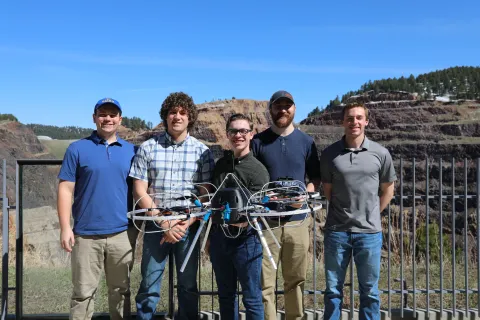
“This unique project allowed us to kind of understand how to work in a team, how to go from concept to designing to actually implementing items and creating something physical that can do the job,” said Tanner Coverstone.
He added that the challenges encountered during the project, like supply-chain management for obscure parts, provided extremely valuable takeaways. “Having this experience before I go do an engineering career makes me feel more comfortable knowing I can handle the position I'm going into. This has just opened my eyes to complications I didn't think I wasn't even aware of.
This team also learned that complications they will face in their careers might be more than technical. Evan Oppelt noted the importance of customer relations in this project. “We had a meeting every two weeks with Jason Cannot, the engineer at SURF. We shared the progress on the drone. We laid out issues we were facing and shared the successes,” Applet said.
“Customer relations are a huge part of what we learned, and Jason was great for this and great to work with,” Martin Mittelstadt added.
The ability to safely inspect hard-to-reach areas inside deep vertical shafts is an on-going effort at SURF that includes the work of previous engineering students and interns. This year’s SDSU drone project made important advancements in SURF’s ability to tackle this challenge.
Connot, the underground operations engineer at SURF, gives praise to this team. “This was a great group of students who were very well organized and who worked really well together. The problem-solving skills they gained during the last year of work will be of value to them throughout their entire careers. They did phenomenal in that,” he said.
‘Most fun parts of our college career’
For students, these projects became more than hard work and problem solving. Haley Evenson on the liquid nitrogen transporter team summed it up best.
“This project was one of the most fun parts of our college career, like this is really what we are working so hard for,” Evenson said.
The fun and hard work paid off for both teams. Each of these students are going on to jobs or graduate school after college—their work exemplifies the mission of SURF, to advance world-class science and inspire learning across generations.
